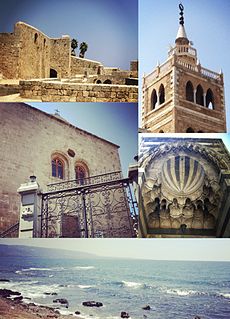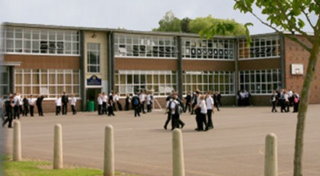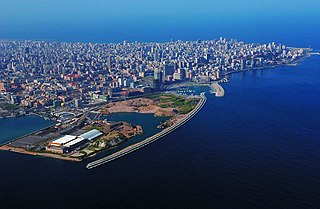The Traveler's Library is a traveling library which, as of January 2014 [update] was located in Tripoli, Lebanon. [1]
A traveling library is a collection of books lent for stated periods by a central library to a branch library, club, or other organization or, in some instances, to an individual. The chief characteristics from which it derives its name are its temporary location in the place to which the collections of books is sent and the implication that any traveling library will or may be changed for another collection of books. A bookmobile is an example.

Tripoli is the largest city in northern Lebanon and the second-largest city in the country. Situated 85 kilometers north of the capital Beirut, it is the capital of the North Governorate and the Tripoli District. Tripoli overlooks the eastern Mediterranean Sea, and it is the northernmost seaport in Lebanon. It holds a string of four small islands offshore, and they are also the only islands in Lebanon. The Palm Islands were declared a protected area because of their status of haven for endangered loggerhead turtles, rare monk seals and migratory birds.
It was founded in 1972 by Ibrahim Sarouj and was moved to an Ottoman period building in the centre of Tripoli in 1982. The building is listed as a heritage site, with reports that it was once the city's saray, built on top of an old American school. Sarouj claimed to house over eighty thousand titles including rare works in Aramaic, Greek, and Armenian amongst other languages. [1]

The Ottoman Empire, also historically known in Western Europe as the Turkish Empire or simply Turkey, was a state that controlled much of Southeast Europe, Western Asia and North Africa between the 14th and early 20th centuries. It was founded at the end of the 13th century in northwestern Anatolia in the town of Söğüt by the Oghuz Turkish tribal leader Osman I. After 1354, the Ottomans crossed into Europe, and with the conquest of the Balkans, the Ottoman beylik was transformed into a transcontinental empire. The Ottomans ended the Byzantine Empire with the 1453 conquest of Constantinople by Mehmed the Conqueror.

In English, a saray, with the variant saraya or seraya (السرايا), is a castle, palace or government building which was considered to have particular administrative importance in various parts of the former Ottoman Empire, such as the Arab provinces, Cyprus, etc. Seray may also be spelt serail in English, via French influence, in which case the L is silent.

A school is an educational institution designed to provide learning spaces and learning environments for the teaching of students under the direction of teachers. Most countries have systems of formal education, which is commonly compulsory. In these systems, students progress through a series of schools. The names for these schools vary by country but generally include primary school for young children and secondary school for teenagers who have completed primary education. An institution where higher education is taught, is commonly called a university college or university, but these higher education institutions are usually not compulsory.
In 2012, the building was reportedly subjected to vandalism in connection with plans to demolish and redevelop the property. [1] In January 2014, unknown assailants torched the library, destroying “two thirds of some 80,000 books and manuscripts housed there,” AFP reported. [2]







